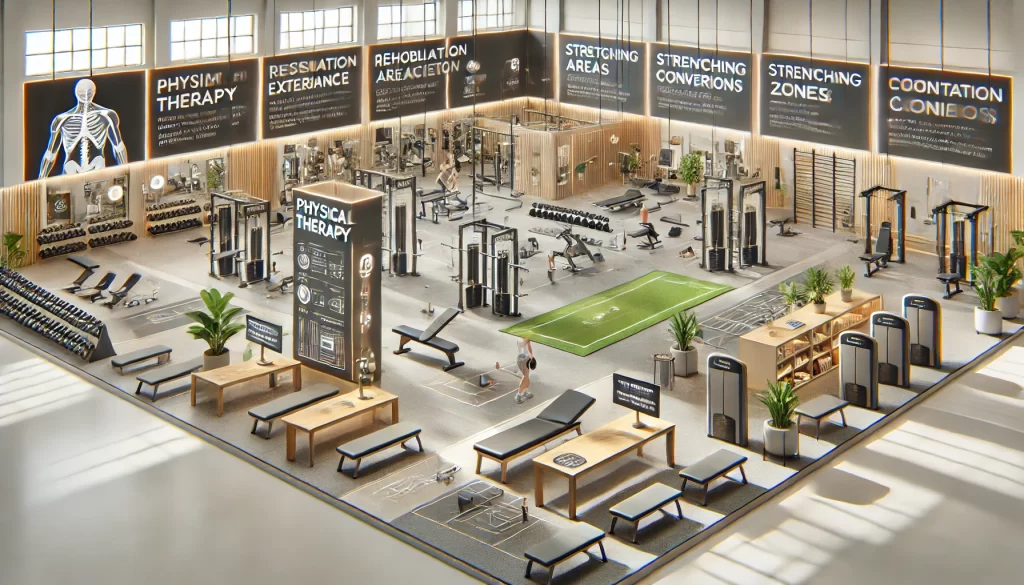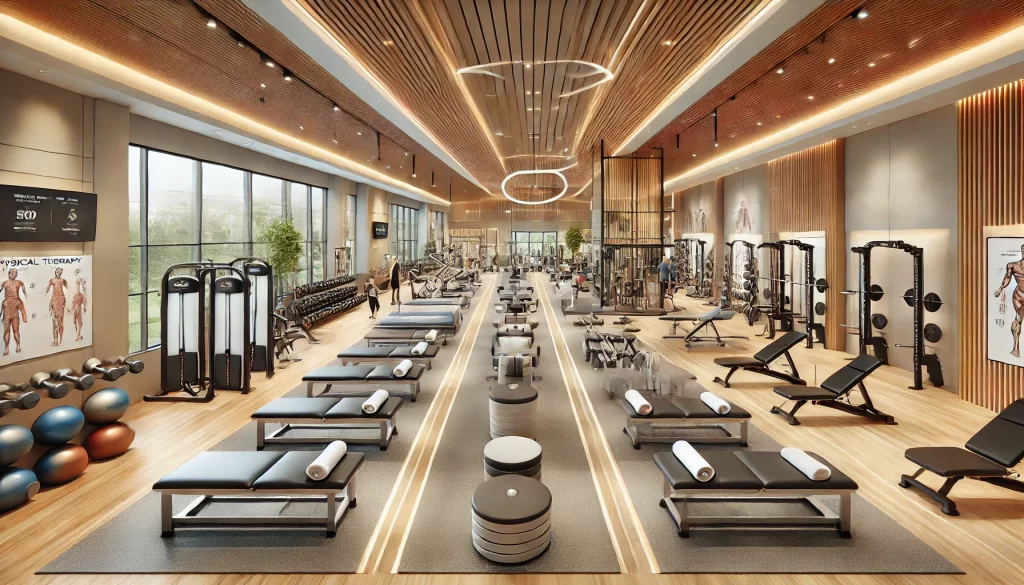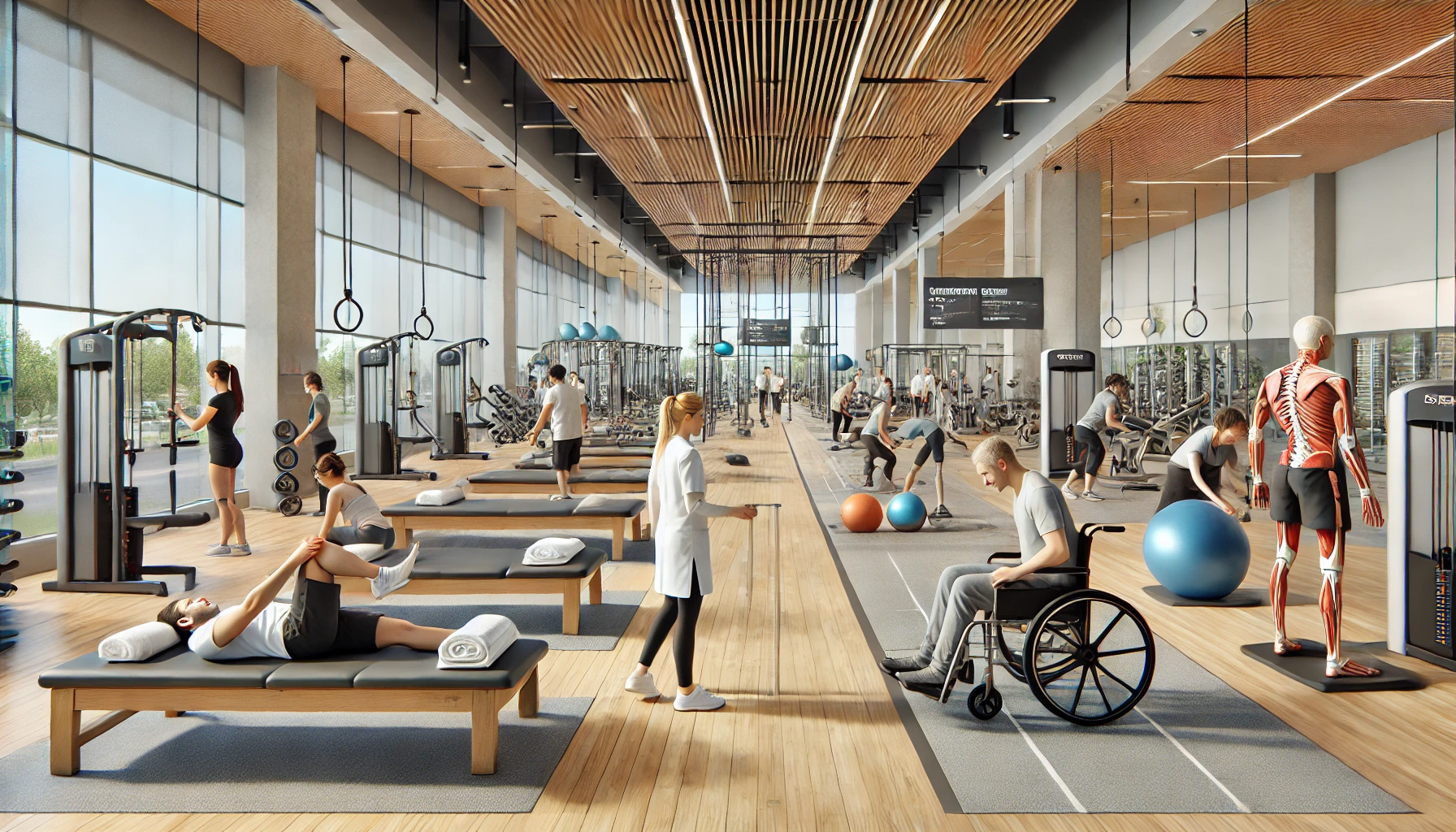Introduction
When designing a physical therapy gym layout, there’s a lot more to consider than simply arranging equipment. Your gym’s layout plays a critical role in shaping your clients’ experiences and directly impacts their satisfaction. It’s not just about the physical space; it’s about how your website, online services, and content are structured to guide users seamlessly from one step to the next.
A well-thought-out layout on your physical therapy gym website can enhance user experience, foster trust, and boost client retention. It allows potential clients to quickly understand your services, find the information they need, and take action – whether it’s booking an appointment, signing up for a class, or reading testimonials. We’ll explore the key elements of a successful physical therapy gym layout, provide layout tips, and offer insights into best practices that will help you design a space and website that is both functional and welcoming for your clients.

Related Posts
Importance of Layout in a Physical Therapy Gym Website
The layout of a physical therapy gym website is crucial in determining how visitors interact with your online presence. Think of your website as the virtual front desk of your gym it needs to guide visitors naturally, provide them with the information they’re looking for, and make it easy to take action. A good layout ensures that users can navigate your site intuitively, find therapy-related services and details quickly, and have a positive experience from start to finish.
How a Good Layout Can Enhance User Experience and Client Retention
When users can easily navigate your website, they are more likely to spend time exploring your offerings. A cluttered, confusing layout can frustrate potential clients, causing them to abandon your site and seek a competitor. On the other hand, a clean, well-organized layout will encourage visitors to stay longer, which translates into higher conversion rates and improved retention.
For physical therapy gym websites, a great layout can:
- Highlight your unique services and treatments.
- Provide simple navigation for easy access to essential features like appointment scheduling and therapist information.
- Create an atmosphere of trust and professionalism through thoughtful design.
Essential Features of a Physical Therapy Gym Layout
To ensure your physical therapy gym layout serves its purpose effectively, there are several key elements you should prioritize. Let’s walk through each of them in detail.
Clear Navigation to Therapy Services
The foundation of any well-designed physical therapy gym website is easy-to-understand navigation. Clients need to find information on therapy services, treatments, and staff quickly. Include clear links to dedicated pages for each of these areas so users don’t feel lost.
A structured menu with logical sections like “Our Services,” “Meet Our Therapists,” and “Available Classes” will guide visitors seamlessly through your site. Consider adding a search bar or quick-access links to make navigation even easier.
Information on Physical Therapists, Classes, and Treatments
Your clients want to know who will be helping them on their journey to recovery. Make sure to dedicate sections of your website to showcasing your team of physical therapists, their specializations, and any credentials that highlight their expertise. Additionally, include detailed information on classes, therapies, and treatments offered at your gym.
Include bios for each therapist, their areas of expertise, and their approach to physical therapy. Offering personal touches such as testimonials or success stories from past patients can further humanize your website and increase trust.
Booking System for Appointments or Consultations
A streamlined booking system is one of the most important elements in a physical therapy gym layout. The easier it is for visitors to schedule an appointment, the higher the chance of conversion. Your booking system should be easily accessible from the homepage or service pages and should allow clients to book consultations, therapy sessions, or classes at their convenience. Integrating a scheduling system with a client portal can further enhance the user experience. Clients will appreciate the ability to manage their appointments and even track their therapy progress online.
Testimonials and Success Stories from Patients
Nothing builds trust like testimonials from real clients. Adding a section for success stories or client testimonials can significantly increase your credibility. Prospective clients want to know that your services can help them achieve their therapy goals.
Include before-and-after stories, quotes, or even video testimonials to make the content more engaging. Client stories can demonstrate your gym’s impact and establish your authority as a trusted source for physical therapy.
Layout Tips for Physical Therapy Gyms
Now that we’ve covered essential features, let’s dive into layout tips that can help you design a welcoming and functional space for your online visitors.
Using Calm Colors and Relaxing Design
Physical therapy is about healing, so your physical therapy gym layout must reflect that calming environment. Opt for colors that promote relaxation, such as soft blues, greens, or neutral tones. Avoid using overly bright or aggressive colors that might make visitors feel tense or stressed.
The design should be minimalistic yet warm. Plenty of white space allows visitors to focus on what’s important without feeling overwhelmed. It’s about creating a sense of calm and safety something your clients can associate with healing.
Accessibility Features and Easy-to-Find Contact Information
Accessibility should be a priority in any gym website layout. Your website should be navigable by users with disabilities, with accessible features such as alt text for images, text-to-speech capabilities, and a clear, readable font.
Additionally, make sure your contact information is easy to find. Display your phone number, email, and physical location prominently, either in the top navigation bar or in a sticky footer, so visitors can get in touch with you whenever needed.
Visual Hierarchy for Therapy-Related Content
A strong visual hierarchy ensures that your content is presented in an organized and logical way. Therapy-related content should stand out, as this is the core service your website offers. Use larger headings, bold fonts, and high-quality images to draw attention to important areas such as your services, client testimonials, and booking system.
Break up large blocks of text with headings and subheadings to improve readability. Ensure that each page’s layout flows smoothly, leading visitors to the next logical step in their journey—whether it’s learning more about a service or scheduling an appointment.

Related Posts
Best Practices for Layout Design
Great layout design isn’t just about aesthetics; it’s about function and optimization. Here are a few best practices to keep in mind when designing your physical therapy gym website layout.
Responsive Design for Mobile Users
In today’s world, a significant portion of web traffic comes from mobile devices. Your physical therapy gym website layout must be responsive, meaning it adjusts automatically to fit various screen sizes. A responsive layout ensures that mobile users have the same seamless experience as desktop users, preventing frustration and increasing the likelihood of conversions.
Integrating Scheduling Tools and Client Portals
Incorporating scheduling tools and client portals into your physical therapy gym website allows clients to manage their appointments, view treatment plans, and track progress at their convenience. These tools can make your website more interactive and useful, which boosts client satisfaction.
Additionally, integrating payment gateways and insurance verification tools can streamline the administrative process for both clients and staff, making it easier for clients to pay and schedule without unnecessary delays.
Key Takeaways
The physical therapy gym layout plays a pivotal role in ensuring your clients’ experience is positive and that they can access the services they need without frustration. A well-organized website with clear navigation, responsive design, and key features like booking systems and client portals will enhance user satisfaction and increase conversions.
- A clear and intuitive layout improves user experience and client retention.
- Key features include navigation to services, booking systems, and therapist information.
- Consider accessibility, color schemes, and visual hierarchy for better engagement.
- Implement mobile-responsive design and interactive tools like client portals.
Creating an effective physical therapy gym layout involves more than just good design—it’s about making your website easy to navigate, providing useful information, and ensuring your visitors can take action quickly. By focusing on features like clear navigation, therapist information, online booking systems, and client testimonials, you can create a site that not only looks great but functions well and enhances the user experience.
With the right physical therapy gym layout, you can improve client retention, increase conversions, and establish trust in your services. Follow the tips and best practices outlined in this post to create a layout that serves both your business goals and your clients’ needs.
FAQs
Why is layout important for a physical therapy gym website?
The layout determines how easily visitors can navigate the site and access the information they need. A clean, user-friendly design enhances the user experience and encourages conversions.
How can I make my physical therapy gym website more accessible?
Use accessible design practices such as alt text for images, readable fonts, and easy navigation. Ensure that your website is compatible with screen readers and other accessibility tools.
What are the key elements to include in a physical therapy gym website layout?
Key elements include clear navigation, therapist bios, service descriptions, a booking system, and client testimonials or success stories. A mobile-responsive design is also essential.
How can I optimize the booking system on my website?
Make the booking system easy to find, allow clients to book appointments quickly, and integrate client portals for appointment management and progress tracking.
What color scheme is best for a physical therapy gym website?
Soft, calming colors like blue and green are ideal for creating a relaxed atmosphere. Avoid using overly bright colors, which can make visitors feel stressed.
